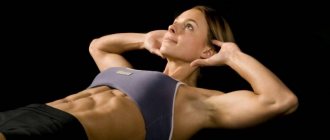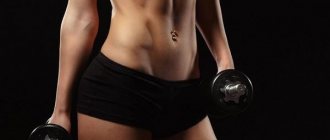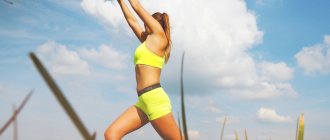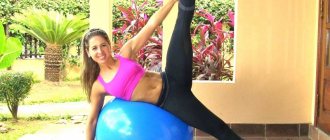— Advertising —
A strong core—which includes the rectus abdominis, obliques, and psoas muscles—helps maintain balance and stability in the body and maintain proper posture and exercise technique. In addition, it helps maintain a stable and safe position of the spine and gives greater control over your movements in general, making them more effective.
“Pilates is a mind-body workout that targets every muscle in your core with every exercise,” says Manuela Sanchez, a Pilates instructor at Club Pilates in New York City. Whether you are doing a movement for the core or other muscle groups, your core remains engaged the entire time. And the training method is to strengthen different areas of your core. “Both the superficial and deep abdominal muscles are worked, and thus your core is significantly strengthened,” says Sanchez, “meaning that the movements work a wide range of muscles, from the deep transverse abdominis to the very top of the rectus abdominis (which is exactly what is called “press”).
Sanchez talked about the most effective exercises for strengthening the abdominal muscles, which will allow you to feel all the benefits of this method. These are classic Pilates exercises, so “Pilates fans will recognize them immediately, but beginners will have no trouble mastering them,” she says. Another plus: None of these exercises require any special equipment, so they can be easily done anywhere.
Manuela suggests choosing a few exercises to warm up before an intense workout. “Then incorporate the rest of the exercises throughout your workout and stay focused on working your core,” she suggests. You can also simply pick a few exercises you like and do them a couple of times during your workout to create your own core routine. If you are a beginner, try doing the exercise for 30 seconds, gradually increasing the time up to a minute.
George Pilates gymnastics
Large muscles that lie on the surface do not make the stomach flat. How to remove the stomach and sides - form a muscle corset from the internal muscles of the abdomen and lower back. Conventional exercises on an incline bench “do not reach” them. The training system created by the Greek George Pilates will help with this. Pilates is a gymnastics exercise that has been used since World War I as a restorative exercise. At the end of the 20th century, stars such as Courtney Love, Janet Jackson, models Stephanie Seymour, Christy Turlington became interested in Pilates, because it really helps to remove belly fat.
Pilates for the abdomen: 9 best exercises
Pilates for the abdomen is considered one of the best options for losing excess fat, regardless of volume, weight or build. The fact is that almost every movement, every step or turn in Pilates is aimed at a specific muscle group. So if your main goal is a perfectly flat stomach, then Pilates is definitely one of the best ways to achieve it. (Moreover, this does not require any gym conditions or special equipment.)
Pilates = flat stomach 20718
So, try these few exercises and you can lose belly fat with Pilates in record time!
Focus on breathing: Pilates for the abdomen (video) 19682
Exercises: Pilates for the abdomen
These nine Pilates exercises will literally sculpt your belly in no time. Follow these nine exercises step by step and in a couple of weeks you will be surprised at the results.
1. Hundred 21204
1. "Hundred". Lie on the floor, stretch and squeeze your legs, and also extend your arms to your sides (A). Raise both legs a few inches off the mat, squeezing your glutes, but in such a way that you also feel a strong tension in your lower abdominal muscles. Raise your head, extend your arms, palms down, parallel to each other, and look at your toes (B). Then raise your hands above your hips and begin to vigorously lower them and raise them up and down. At the same time, hold a long, steady inhalation for five such movements, and then an equally long and steady exhalation for the next five movements (C). The first exercise must be performed in at least two approaches (usually 2 to 5 approaches are performed first, each with 10 repetitions). Over time, you need to reach 100 such “jerks” (hence the name of this exercise in Pilates).
2. Saw 21286
2. "Saw". Sit on the floor with your back as straight as possible and your waist muscles tense. Spread your arms straight out to the sides at shoulder height—extend them so far that you feel like you could literally “crack a nut” between your shoulder blades. With your feet wider than yours, bend them from the ankles so that they are flat against the mat rather than in the air (A). As you inhale, you need to turn your torso as far as possible to the left and hold your hand, palm down, directly above your left knee (B). Exhale and slide your right hand along the outside of your leg in three progressive forward motions, simulating a “sawing” - you should feel tension in the muscles of your lower abs. As you do this, keep the weight of your lower body even on the mat, even though your upper body is trying to lift your lower body off the floor (C). Inhale and return to the starting position. Repeat the sequence, but this time to the right. Perform three approaches (1 exercise counts as a turn to both the left and right sides).
3. Leg stretching 20611
3. “Stretching your legs.” Lie on the mat, hug both knees, pressing them with your hands to your chest, while stretching your head forward and spreading your elbows as wide as possible (A). Breathe with control: inhale as you pull your legs forward and arms back - the limbs should stretch in maximum opposition to each other, only in this way the abdominal muscles will work deeply to support the spine (B). Now exhale slowly and, trying to return to the reverse “hug” position, use the pull of your knees. As you exhale, use your stomach and chest to force more and more air out of your lungs (C). Repeat this exercise 6 times.
4. Crisscross 20762
4. "Criss-cross" Lie on your back, place your hands behind your head and place them palm to palm at the back of your head. Lie with your head up and your knees tightly closed, bent closer to your chest (A). Now slowly inhale and twist your torso to the left until your right elbow connects with your left knee, while straightening your right leg forward (it should be kept 7-10 centimeters above the mat). Exhale and twist to the right, bringing your left elbow as close to your right knee as possible while extending your left leg (B). Continue alternating sides, performing the exercise 6 times (1 time = left + right).
5. Corkscrew 21015
5. "Corkscrew". Lie on your back with your arms extended as far as possible, pressing them tightly to your sides. Tighten your legs throughout your inner thighs, pressing them tightly together. Start lifting your feet off the floor. Inhale slowly as you lift your legs overhead, bending them to the side, balancing your center of gravity in the middle of your back, between your shoulder blades (A). Exhale as you bend your legs and torso to the right (B). When your right gluteus maximus touches the mat, begin to circle your legs back to the left and inhale slowly at the center (C). Tightening your abs, keep your legs off the floor and slightly diagonally in the opposite direction (D). Perform the exercise three times in each direction.
6. One Leg Circles 20800
6. “Circles with one leg.” Lie on the floor, squeezing your legs tightly and extending them to their maximum length. Place your arms at your sides, while your back and shoulders should be pressed to the floor. Extend one leg up toward the ceiling, keeping it as straight as possible and as close to perpendicular to the floor as possible (A). Start drawing circles in the air with this leg according to the pattern: (B, C and D). Keep your breathing under control - synchronize it with your movements. Perform a full five circles in each direction and then switch legs.
7. Difficult task 20811
7. "A difficult task." Lie on the floor with your arms thrown back and extended above your head (biceps should be at ear level). Also stretch the entire length of the leg strongly: the fingers of the lower extremities should be in opposition to the tips of the fingers. Keep your back straight by squeezing your legs tightly together (A). Now begin to sharply lift your limbs off the floor, keeping your back and buttocks on the floor. Keep your hands shoulder-width apart and only then begin to lift your legs (B). Inhale as you move your arms forward. When your arms are parallel to your hips, lift your back off the floor, bringing it towards your legs. At the same time, try not to twist the pelvis - stretch through the vertebrae (C). As you begin to lower yourself to the starting position on the floor, exhale slowly. Do this exercise three times.
8. Swimming 20761
8. "Swimming." Lie on your stomach, lower your head with your forehead down, your stomach and pelvis should be pressed tightly to the mat, and your legs should be pressed together along the entire inner surface of your thighs. Keep your arms extended forward, palms down, and your legs extended even to the toes. Raise your arms, legs, chest and head in one jerk and hold them in this position for several seconds (A). Now inhale and exhale as you begin to “row” with your arms and legs, alternating your right arm and left leg (B) and your left arm and right leg (C), but without touching your limbs to the mat. Perform this exercise for several minutes: slowly, raising your limbs higher and higher.
9. Tilt to the sides 20841
9. "Tilt to the sides." This is the most difficult exercise in Pilates for the abdomen. Sit on one hip with your hand on one side for support and your legs slightly bent to the side on the floor with your ankle stacked over your ankle (A). Inhale as you lift your hips up off the mat and extend your arm overhead, forming a high arc through your torso (B). Move your hand back to your outer thigh and turn your chin toward it (C). Exhale slowly as you lower yourself back down to the floor. Repeat 3 cycles (6 exercises in total - 3 in each direction).
Bonus: Pilates for the stomach and sides (video) 19686
Features of the classes
Pilates does not load individual muscles, but involves the entire abdomen, lumbar spine, and back as a whole. Pilates is not only a way to get rid of your belly and sides, but also an opportunity to strengthen your spine. Pilates combines the interests of weight loss and health. Exercises can be practiced at any age, with any state of health and figure. Experts recommend doing Pilates for very plump ladies for whom it is important to stabilize the spine. Pilates exercises maintain the correct position of the spine.
Alternate leg stretching
Lie on your back, press your shoulder blades and sacrum to the floor, maintain a natural arch in your lower back. Smoothly twist your body forward: lift the back of your head, neck, shoulder blades and shoulders above the floor, press your lower back. Extend your arms forward and lift your legs off the floor. Bend your left knee, press your thigh to your stomach, helping yourself with your hands, extend your right leg forward and up (at an angle of 45° to the floor). Then, maintaining the position of the body and spine, change legs: bend your right knee, press your right thigh to your body, extend your left leg forward and up. This will amount to one repetition, perform 10-15 such repetitions.
Intelligent body
This method of how to remove the belly and sides belongs to the area of fitness called “Reasonable Body”. The main thing in training is to be aware of every action, feel your breathing, and perform the exercises efficiently. In addition to unstable poses, special sports devices are used - unstable Balance Pad or BOSU platforms. The internal muscles are responsible for balance. Muscles, trying to hold the body, stretch and contract. Pilates also includes exercises aimed at strengthening joints and ligaments.
Tips for beginners and how to practice correctly
Like any new activity that a person begins to do for the first time, the Pilates exercise system for beginners should begin with general familiarization and introductory classes. To do this, you should use the services of a professional trainer or instructor. However, thanks to the Internet, today it is not at all necessary to visit the training room to master the popular complex. If you wish, you can perform Pilates at home, not only by reading the sequence and technique of the exercises, but also by watching videos and photographs.
However, Pilates is considered a rather complex complex in terms of technique. In order not to nullify all your efforts, try to adhere to the basic rules , which are relevant, first of all, for beginners:
- pay attention to your breathing during training - breathe through your chest , trying to open your ribs wider when you inhale and contract your muscles as much as possible when you exhale
- constantly control your abs - keep it tense throughout the entire session, drawing energy and distributing it to the entire body, all movements should come from the abs
- follow the recommendations as accurately as possible and take the correct position - an uncomfortable or incorrect position can not only not be beneficial, but also harm the body
- shoulders , during most exercises, should be lowered - this is of great importance for proper breathing, because with lowered shoulders, the chest opens wider
- keep your head straight without throwing your chin back or pressing your chin to your chest - when doing exercises on the floor or on all fours, this allows you to use muscle groups that are difficult to work under normal conditions
- try to stretch your spine throughout all exercises - you increase the distance between the spinal discs, making your body more flexible and mobile
There are a number of other recommendations that a Pilates trainer can give you. It is enough to attend two or three training sessions to understand the basic rules and be able to further perform Pilates exercises at home, without the constant supervision of an instructor.
How this Pilates workout should be performed
Carefully study all the proposed components of the workout in order and then begin to perform them in accordance with the time schedule at the end of this article.
Are you already a Pilates pro and not a beginner? Just do each exercise for longer than the prescribed time. Slow movements and focusing on correct execution can help even advanced athletes feel the muscles warm up. To make the task more challenging, Sarah Ruback suggests holding dumbbells weighing up to 1 kg during exercises.
"Mermaid"
Sit on the floor, bend your knees and lower your legs to the left. Shift your shins slightly so that your left foot rests on your right thigh and your right foot rests behind your pelvis. Stretch your head up, do not bend at the lower back. Place your right hand behind your head, bending your elbow, and place your left palm on the mat. From this position, smoothly lean your body to the left, dropping as low as possible and leaning on your left hand. At the bottom point, twist your body forward and down, reaching with your left elbow towards your right palm on the floor. Smoothly return to the starting position for one repetition. Perform 10-12 such repetitions in each direction.
Do this program regularly to keep your muscles toned.










